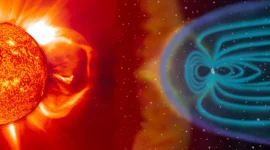July 11, 2025. Our Space & Science Correspondent
Just when we thought the solar system’s grand drama was a family affair, a new and spectacular character has crashed the stage. On the night of July 1, 2025, a faint point of light, no brighter than a distant star, was detected by the Asteroid Terrestrial-impact Last Alert System (ATLAS) survey telescope in Rio Hurtado, Chile. Within hours, a global network of astronomers, captivated by its impossible speed and trajectory, confirmed its otherworldly nature. This cosmic interloper is no ordinary comet; it is 3I/ATLAS, only the third confirmed object to enter our solar system from the vast emptiness between the stars.
The discovery, initially made by the NASA-funded project, was more of a re-discovery. While the official alert came on July 1, a deep dive into data archives from other ATLAS telescopes and the Zwicky Transient Facility at the Palomar Observatory revealed “pre-discovery” observations extending back to mid-June. The object, initially designated A11pl3Z, was a cosmic needle in a haystack, a tiny speck of light moving far too quickly to be a resident of our sun’s gravitational well. Its high-speed, hyperbolic trajectory—with an eccentricity far exceeding that of any object bound to our sun—was the definitive signature of an interstellar visitor. It was an object born around a distant, long-dead star, ejected into the interstellar void, and now, by chance, on a fleeting pass through our cosmic neighborhood.
The excitement among astronomers is palpable, and for good reason. The discovery of 3I/ATLAS marks a pivotal moment in planetary science. While the first two interstellar objects, ‘Oumuamua (2017) and 2I/Borisov (2019), were astronomical appetizers, this newcomer promises to be a full-course meal. It is a tangible link to a star system far, far away, carrying with it a story millions or even billions of years in the making.
A New Benchmark for Interstellar Interlopers
To understand the significance of 3I/ATLAS, one must first look back at its predecessors. The first, ‘Oumuamua, was a bizarre, cigar-shaped object that baffled scientists. Its unusual shape and non-gravitational acceleration sparked wild theories, including that it could be an alien probe. While those theories were largely dismissed, ‘Oumuamua’s rapid departure and lack of a definitive cometary tail made it a frustratingly brief and enigmatic subject of study. The second, 2I/Borisov, was a more conventional comet, but it was also small and faint, limiting detailed observations.
Now, we have 3I/ATLAS. Preliminary estimates suggest it is a leviathan by comparison, with a nucleus possibly as large as 20 kilometers in diameter. Its sheer size and cometary nature make it a far more promising target for scientific instruments. As it speeds toward its closest approach to the sun in late October, when it will pass just inside the orbit of Mars, the sun’s warmth is heating its icy core. The sublimation of frozen gases is already creating a discernible coma and a faint tail, making it a “textbook” interstellar comet. This activity is precisely what excites scientists, for the gases and dust it sheds are a treasure trove of information.
“This is a game-changer,” says Dr. Elena Petrov, a planetary scientist at the European Southern Observatory. “We’ve gone from a single, strange data point with ‘Oumuamua, to two, and now a third. It’s like going from having one sentence of a story to having three. We can finally start to see patterns, to build a population model of these interstellar objects and understand how they are formed and ejected from their parent star systems.”
The composition of 3I/ATLAS’s coma and dust tail, which can be analyzed by ground-based and space telescopes, is the key. Every celestial body is a chemical snapshot of the environment in which it formed. By studying the chemical signatures—the ratio of different isotopes, the presence of specific organic molecules—scientists can gain unprecedented insights into the conditions of a distant, alien stellar nursery. Does this comet contain different types of ices or minerals compared to comets from our own Oort Cloud? Does it contain complex organic molecules, the building blocks of life, which could offer tantalizing clues about the abundance of such material in other star systems? These are the questions that will be answered in the coming months.
An Ancient Wanderer with a Galactic Pedigree
Perhaps one of the most surprising findings about 3I/ATLAS is its possible origin. A recent preprint by a team of astrophysicists suggests the comet came from the thick disk of the Milky Way, a region of the galaxy that is home to a relatively small percentage of its stars. The analysis, based on the comet’s exceptionally high velocity, indicates an age far greater than our solar system’s. This implies that the comet was ejected from its home star system billions of years ago, a relic of an ancient, long-forgotten planetary formation event.
This finding challenges previous assumptions and adds a new layer to our understanding of the galactic environment. Interstellar objects aren’t just modern-day exoplanets-in-exile; they can be ancient, primordial fossils of early galactic history. They are the cosmic equivalent of archaeological artifacts, pieces of a past that we can now, for the first time, hold and analyze.
For Dr. Matthew Hopkins, the lead author on the preprint, the revelation is profound. “The fact that this object appears to be so much older than our own sun tells us that the process of planetary systems ejecting material into interstellar space has been going on for a very long time,” he explains. “It’s a powerful validation of our theories of planetary formation and galactic dynamics, and a reminder of just how interconnected our universe is.”
The scientific community is now racing against the clock. Although 3I/ATLAS will be observable by telescopes for several months, its closest approach is a critical window. This is when its cometary activity will be at its peak, and when the most detailed spectroscopic and imaging data can be collected. Telescopes around the world and in space, including the Hubble and James Webb Space Telescopes, are already being pointed in its direction.
“Every observation counts,” says Dr. Sarah Johnson, an astronomer at the University of Hawaii. “We are coordinating a massive, global campaign to track this object. We want to measure its composition, its size, its rotation, and its behavior as it interacts with the sun’s radiation. This is a once-in-a-lifetime opportunity to study an object from a different solar system up close, and we have to make the most of it.”
A Broader Vision for Cosmic Science
Beyond the immediate scientific gains, the discovery of 3I/ATLAS has a more subtle, yet equally important, impact. It serves as a powerful reminder of the value of basic scientific research and the infrastructure that enables it. The ATLAS survey, which discovered the comet, was primarily built to identify potentially hazardous near-Earth asteroids. The fact that it found something so profoundly unexpected and scientifically significant highlights the serendipitous nature of discovery and the wisdom of investing in a broad range of scientific endeavors.
As discussions about science funding continue in legislative bodies around the world, objects like 3I/ATLAS serve as a powerful public relations tool for the astronomical community. They capture the imagination, inspiring a sense of wonder and excitement that transcends borders and disciplines. They remind us that the universe is not just a distant, abstract concept but a dynamic, ever-changing place full of surprises.
The search for more interstellar objects is only just beginning. With the Vera C. Rubin Observatory in Chile set to come online in the near future, astronomers anticipate a tidal wave of new discoveries. Its massive, wide-field camera will survey the entire visible sky every few nights, increasing the chances of finding more faint and fast-moving objects. 3I/ATLAS is a taste of what’s to come—a harbinger of a new era of discovery where we will be able to build a true census of the interstellar material flowing through our solar system.
In a universe full of mysteries, 3I/ATLAS is a precious gift. It’s a cosmic message in a bottle, a testament to the fact that we are not alone, not in the sense of intelligent life, but in the sense that our solar system is just one of countless others, all a part of the same grand, magnificent galactic story. Its journey began eons ago around a star we will never know, and after its brief, dazzling pass, it will continue its silent voyage into the deep. But for a few short months, it is our guest, and we will watch and learn from its silent, majestic passage.




